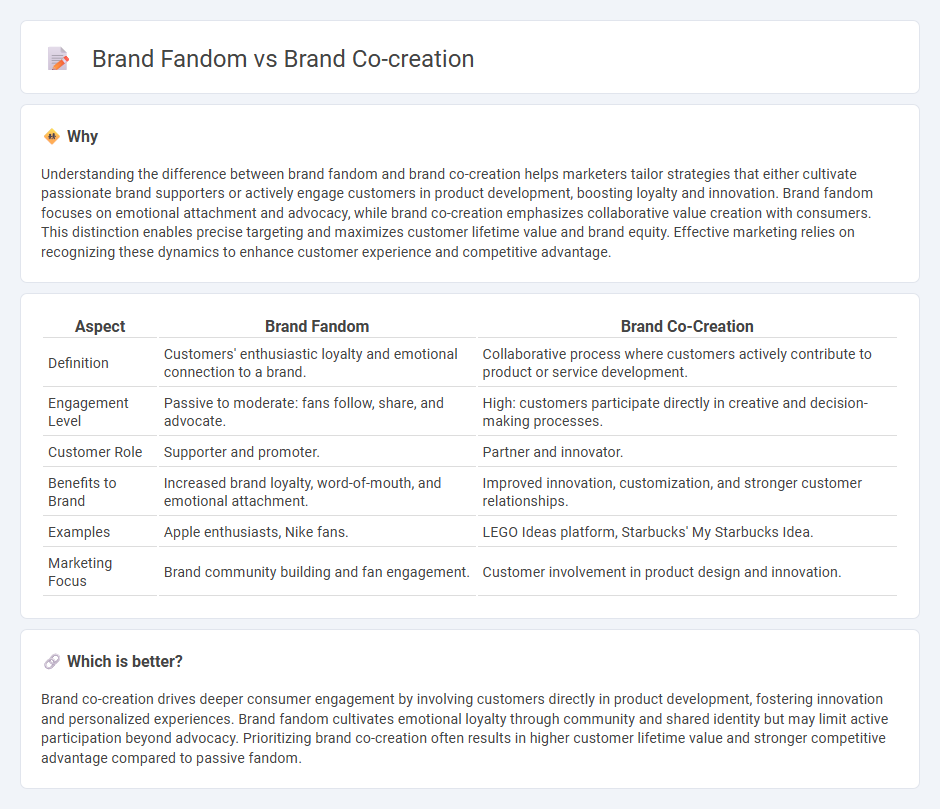
Brand fandom creates a loyal community passionate about a brand's identity and values, fostering emotional connections that drive repeated engagement and advocacy. Brand co-creation involves customers actively participating in the development and refinement of products or campaigns, enhancing innovation and personalized experiences. Explore how these strategies transform marketing dynamics and elevate consumer-brand relationships.
Why it is important
Understanding the difference between brand fandom and brand co-creation helps marketers tailor strategies that either cultivate passionate brand supporters or actively engage customers in product development, boosting loyalty and innovation. Brand fandom focuses on emotional attachment and advocacy, while brand co-creation emphasizes collaborative value creation with consumers. This distinction enables precise targeting and maximizes customer lifetime value and brand equity. Effective marketing relies on recognizing these dynamics to enhance customer experience and competitive advantage.
Comparison Table
| Aspect | Brand Fandom | Brand Co-Creation |
|---|---|---|
| Definition | Customers' enthusiastic loyalty and emotional connection to a brand. | Collaborative process where customers actively contribute to product or service development. |
| Engagement Level | Passive to moderate: fans follow, share, and advocate. | High: customers participate directly in creative and decision-making processes. |
| Customer Role | Supporter and promoter. | Partner and innovator. |
| Benefits to Brand | Increased brand loyalty, word-of-mouth, and emotional attachment. | Improved innovation, customization, and stronger customer relationships. |
| Examples | Apple enthusiasts, Nike fans. | LEGO Ideas platform, Starbucks' My Starbucks Idea. |
| Marketing Focus | Brand community building and fan engagement. | Customer involvement in product design and innovation. |
Which is better?
Brand co-creation drives deeper consumer engagement by involving customers directly in product development, fostering innovation and personalized experiences. Brand fandom cultivates emotional loyalty through community and shared identity but may limit active participation beyond advocacy. Prioritizing brand co-creation often results in higher customer lifetime value and stronger competitive advantage compared to passive fandom.
Connection
Brand fandom fuels deep emotional connections and active consumer engagement, which drives enthusiasm for brand co-creation initiatives. Loyal brand fans contribute valuable insights, creative ideas, and authentic content that shape product development and marketing strategies. This participatory relationship enhances brand loyalty, innovation, and consumer trust, creating a mutually beneficial ecosystem.
Key Terms
**Brand Co-creation:**
Brand co-creation involves active collaboration between a company and its customers, where consumers contribute ideas, feedback, and innovations to shape products or services, enhancing brand value and loyalty. This participatory approach drives innovation and creates a more personalized brand experience that resonates deeply with target audiences. Explore strategies to leverage brand co-creation for stronger customer engagement and competitive advantage.
Customer Participation
Brand co-creation involves active customer participation in the development and enhancement of products or services, fostering a sense of ownership and personalized experience. In contrast, brand fandom centers on passionate customer loyalty and emotional attachment without direct influence on product creation. Explore how engaging customers through co-creation strategies can amplify brand loyalty and innovation.
Value Collaboration
Brand co-creation emphasizes active consumer involvement in developing products, services, or brand experiences, fostering a collaborative value exchange that enhances brand relevance and innovation. Brand fandom centers on emotional attachment and loyalty, where fans generate value through advocacy and community engagement without direct input in brand development. Explore the strategic differences and synergies between these concepts to maximize value collaboration and drive brand growth.
Source and External Links
Customer Co-Creation Examples: 12 Companies Doing It Right - Brand co-creation involves inviting stakeholders, usually customers or employees, to participate collaboratively in design or problem-solving, producing mutually valued outcomes like new products, innovations, or branding directions.
Co-Creation: The Proven Path to Skyrocketing Brand Loyalty - Co-creation enhances brand loyalty by integrating customer feedback and diverse perspectives during product development, fostering innovation and making customers feel valued and integral to the brand's success.
Customer Co-Creation: 14 Top Examples to Fuel Your Co ... - ITONICS - Examples like NikeID and Betabrand show how brands empower customers to personalize or shape products, deepening emotional connections and driving innovation, illustrating effective co-creation strategies across industries, including luxury brands like BMW and Accor.
 dowidth.com
dowidth.com